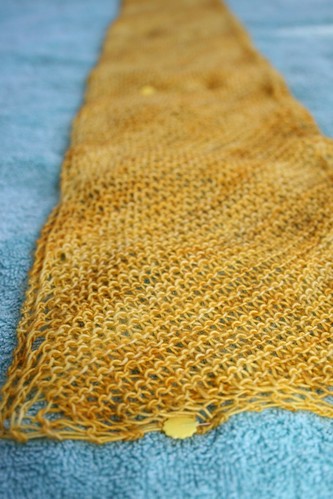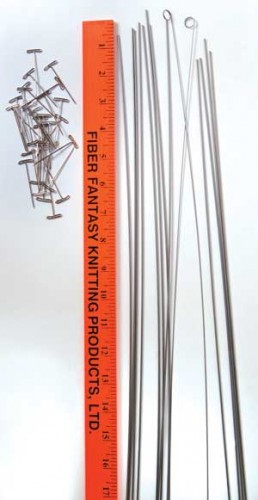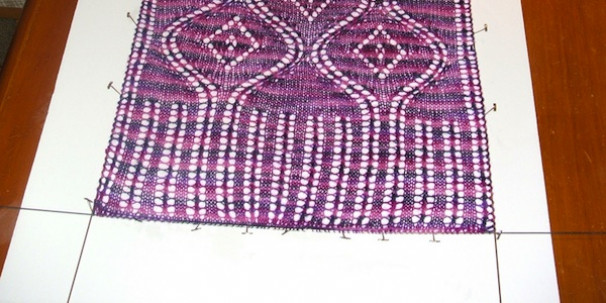Let’s have a discussion about blocking your knitting.
Blocking is the process of manipulating the shape of your knit pieces after you are finished knitting, but before you seam or wear them.
There are two common methods of blocking “wet” and “dry”.
Wet blocking is where you submerge your piece in water, pull it out carefully, lay it out in the shape that you want, and let it dry.
Dry blocking involves either steam or mist. You take the piece and pin it down in the shape you want. You can pin the piece to a towel or a mesh sweater drying rack. If you have an iron that can “shoot steam” you can use that or a mister bottle (with no chemicals in it. No old plant-mister or hair-mister bottles, please). Steam or mist the project until it is moist.

With either method, the fibers relax from their “just knit” shape, and take on the new shape that you have negotiated them into. Now, the piece needs to dry. I recommend leaving them flat on the bed, in that west-wing spare guest room that you have.
You do not need fancy tools to block. A towel and pins will work fine. However. If you have a budget for fancy tools (good for you!), and you knit lace, you might want to invest in blocking wires.
 The set shown here is available at Pattern Works. Or try your local knitting shop. I’m sure they would love to hear about it if you are doing this lovely kind of lace knitting. And we always want to shop locally, if that is an option. (My tiny soap box for the local knitting shop. Thank you.)
The set shown here is available at Pattern Works. Or try your local knitting shop. I’m sure they would love to hear about it if you are doing this lovely kind of lace knitting. And we always want to shop locally, if that is an option. (My tiny soap box for the local knitting shop. Thank you.)
Here, knitter Stacey shows her scarf Seascape blocked on wires. The pins are holding the wires in place.
(The pattern was written by Kieran Foley and is available on Knitty)

(Picture by Stacey, from her flicker set. She does a whole set of pictures about wet blocking her piece. That is beautiful knitting Stacey.)
You can see that having a wire will hold the piece at millions of points. You could pin this, but that would involve an unwieldy number of pins. To offer some tension on the piece while it is drying, Stacey uses a piece of cardboard wrapped in cling film or wrapping film. That way you have something to stick the pins in, but still have a barrier against the moisture. If you use foam core, the moisture will warp the board. (And do NOT use colored board, as the colors may bleed.)
As for which method is better, that depends on your project.
For something like a sweater, I would not wet block. Submerging a big piece of knitting will make it really heavy. The process of lifting it to the towel, and getting even some of the water out means running the risk of really stretching the piece in ways that you never anticipated. The weight of the water becomes too much. For a small, or delicate piece like this one, wet blocking is fine. The piece will need to be stretched quite a bit, and the water will not weigh the piece down too much.
Beautiful finishing is a big part of a beautiful knitting.
Do you block your knitting? What are your tricks for a beautifully finished piece?
Happy knitting!
© 2005 – 2012 Kathy Lewinski & Susan Cornish



